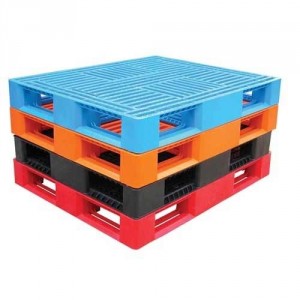 Despite their 19th Century technology, pallets remain one of the most important tools in the supply chain. Every year, billions of products are packed onto pallets and transported worldwide in trucks, trains, planes and barges.
Despite their 19th Century technology, pallets remain one of the most important tools in the supply chain. Every year, billions of products are packed onto pallets and transported worldwide in trucks, trains, planes and barges.
But what does the future hold for pallets? And will they continue to play such a central role in materials handling over the next decade?
Bob Trebilcock, executive editor of Modern Materials Handling, recently sat down for an interview about the significance and future development of the humble packing pallet and whether it will remain the primary global packaging platform.
One Word: “Plastics.”
While wood remains the most common pallet material, plastics are rapidly increasing their market share. That’s because plastic pallets offer innovations that wood pallets can’t provide, especially in the food and drug industry’s ability to do a recall, Trebilcock said.
“What the food industry is trying to do is catch the problem before it even goes into finished, packaged products and is ever shipped out,” Trebilcock said. “This would prevent ever having to do a recall in the first place. The plastic pallet market has come up with additives that show up in a fluoroscope or some other inspection method if a piece of the plastic pallet has contaminated the batch of the material being manufactured.
“If you are a cereal manufacturer and a piece of the plastic pallet has chipped off and somehow gotten into a batch of product, when the inspection is done the additive will show up in the test so the manufacturer can catch the contamination before the product is every packaged and sent out to the market,” he said. “This prevents a recall. That is a trend that is driving the plastic pallet market right now.”
Plastic pallets also provide more versatility than the standard 48″ x 40″ wood pallet. Half-size and quarter-size pallets plastic pallets are more in demand thanks to the rise in grocery and convenience stores. This allows smaller loads and more frequent delivery schedules, according to Trebilcock.
Customized Pallet Sizes
Pallet sizes could be changing because industries are moving toward more customized packaging sizes. For example, Amazon — the world’s largest online retailer — used only three basic box sizes up until recently. Customer’s orders were packaged and then air bags were inserted to fill the remaining space.
“The old days of shipping like that just don’t work anymore,” said Trebilcock. “Now companies are looking at the entire packaging from the beginning and not just treating it as an afterthought.”
For example, the office supply retailer Staple — which happens to be the second larges online retailer after Amazon — is now using on-demand packaging, in which the boxes are customized to fit the size of the product being shipped. Because there are fewer standard-sized packaging boxes, in the coming decade there will be fewer standard-sized pallets, according to Trebilcock.
Advancement in Robotics
Advancements in industrial robotics are also expected to change the landscape of materials handling.
“Every company is taking a look at automation to see where it can make economic sense,” said Trebilcock. “I think we are a ways off before the technology is where it can go live in a big way. But it wouldn’t surprise me if in five years, some grocery distribution centers have robots instead of people going down the aisle picking cases to be placed on pallets.”
